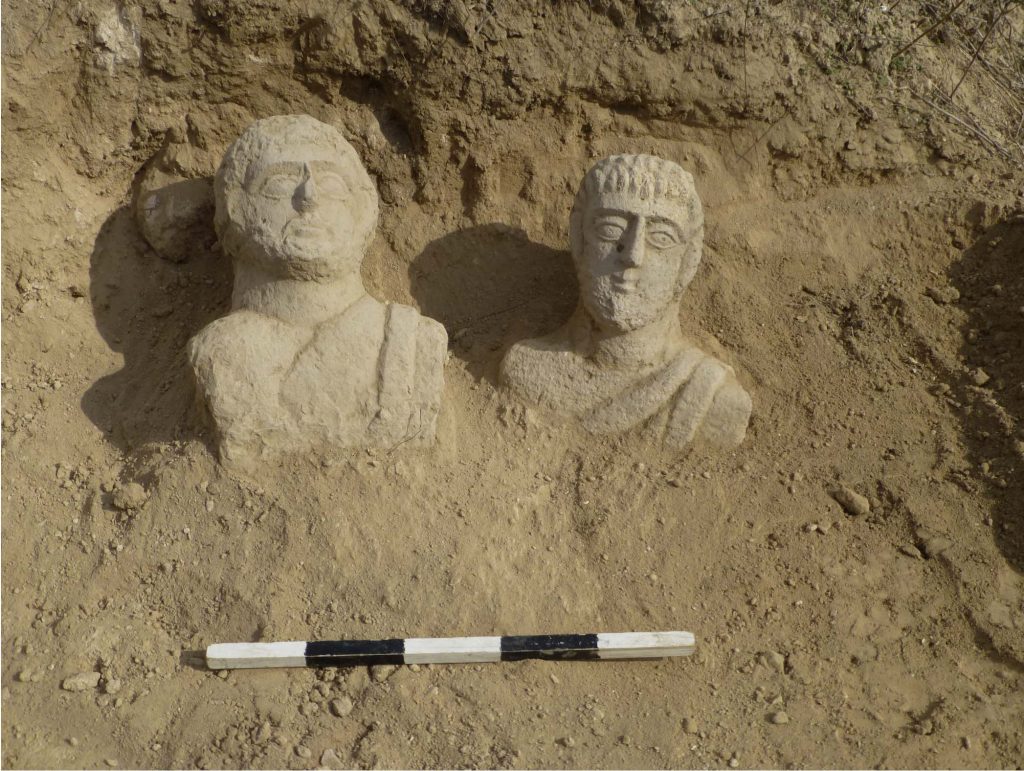A fifth-century Samaritan Mosaic Discovered at Zur-Nathan
A 5th-century Blessing Inscription was discovered at Zur-Nathan in the Sharon Plain during a survey and excavation directed by the Israel Antiquities Authority. The Greek inscription reads: ‘Only God, help the beautiful property of Master Adios, Amen’.

The inscription was discovered in an impressive wine-press that was apparently part of the agricultural estate of a wealthy individual called Adios. The inscription’s formula and the location of discovery points to the estate belonging to Samaritans.
According to Hagit Torge, director of the excavations: ‘This is only the second such winepress discovered in Israel with a blessing inscription associated with the Samaritans. The first was discovered a few years ago in Apollonia near Herzliya’.
The inscription in the wine-press is additional testimony to once-extensive Samaritan settlement in the southern Sharon Plain during the Byzantine period.
Two Funerary Busts from Beit She’an
A local woman taking a winter walk near the city of Beit She’an spotted two funerary busts sticking up out of the ground, apparently exposed by the rain. The woman called the Antiquities Theft Prevention Unit (ATPU) of the Israel Antiquities Authority who transferred them to the national Treasury.

The statues have been dated to the the 3rd–4th centuries CE, the Late Roman Period. They are made of local limestone and closely describe facial and dress features.
Dr. Eitan Klein from the Israel Antiquities Authority who studied the busts said: ‘Funerary busts were often located in or around burial chambers, and appear to generally describe the deceased. Similar statues have been found near Beit She’an and in northern Jordan, but no two are alike. These two busts were made in the oriental style, testifying to the waning of the classical styles and adoption of local styles in this region during the Late Roman Period’.
Antiquities Looters Caught at Khirbet Huqoq Synagogue
Two looters were caught at the ancient Synagogue of Khirbet Huquq in the lower Galilee. The two were caught red-handed by inspectors of the Antiquities Theft Prevention Unit (ATPU) while illegally digging in search for ancient coins, aided by a metal detector and digging equipment.

The looters had been under surveillance from the moment they arrived on the site. According to Nir Distelfeld from the Israel Antiquities Authority ‘the two had ancient coins in their pockets. They succeeded to dig dozens of shallow pits into the site’s surface, permanently damaging archaeological strata’.
Khirbet Huqoq has been studied by Archeologists since the 19th century. Since 2011 it has been excavated by archeologists from the University of North Carolina, headed by Prof. Jodi Magness, and assisted by the IAA and the Tel Aviv University. During the excavation a 5th-century synagogue adorned with magnificent mosaics has been found.
A Greek Inscription with the City’s Name Uncovered at Haluza
A Greek inscription mentioning the city’s name was uncovered during an excavation at Haluza in the western Negev.

Excavations at the site have been ongoing for the past three years, led by a team of the German University of Cologne under the direction of Prof. Michael Heisenelmann and a team of students from the University of Cologne and the University of Bonn, in cooperation with Dr. Tali Erickson-Gini from the Israel Antiquities Authority.
The name Haluza is mentioned in historical sources, but this is the first evidence for the name of the city to be found at the site itself. The text, which read ‘Elusa’ in Greek, is currently being studied by Professor Leah Di Segni of Hebrew University. The site ceased to exist in the 7th century C.E., but the name Haluza was commemorated in the Arabic name for the ruins: Al-Khalasa.
A Bulla of ‘Natan-Melech the King’s Servant’
A bulla bearing the Hebrew name ‘Natan-Melech the King’s Servant’ was uncovered during archaeological excavations of the Givati Parking Lot in the City of David, carried by Prof. Yuval Gadot of Tel Aviv University and Dr. Yiftah Shalev of the Israel Antiquities Authority.
The artefact was discovered inside a public building that was probably destroyed during the Babylonian destruction of Jerusalem in 586 BCE.
The name Nathan-Melech appears once in the Bible, in the second book of Kings 23:11, where he is described as an official in the court of King Josiah, who took part in the king’s religious reforms. The title ‘Servant of the King’ frequently appears in the Bible to describe a high-ranking official close to the king.
Information in this report was kindly provided by Dr Eitan Klein, Deputy Director of the Unit for the Prevention of Antiquities Looting in the Israel Antiquities Authority, an Archaeologist of the classical periods and a Lecturer at the Land of Israel Department at Ashqelon Academic College.

